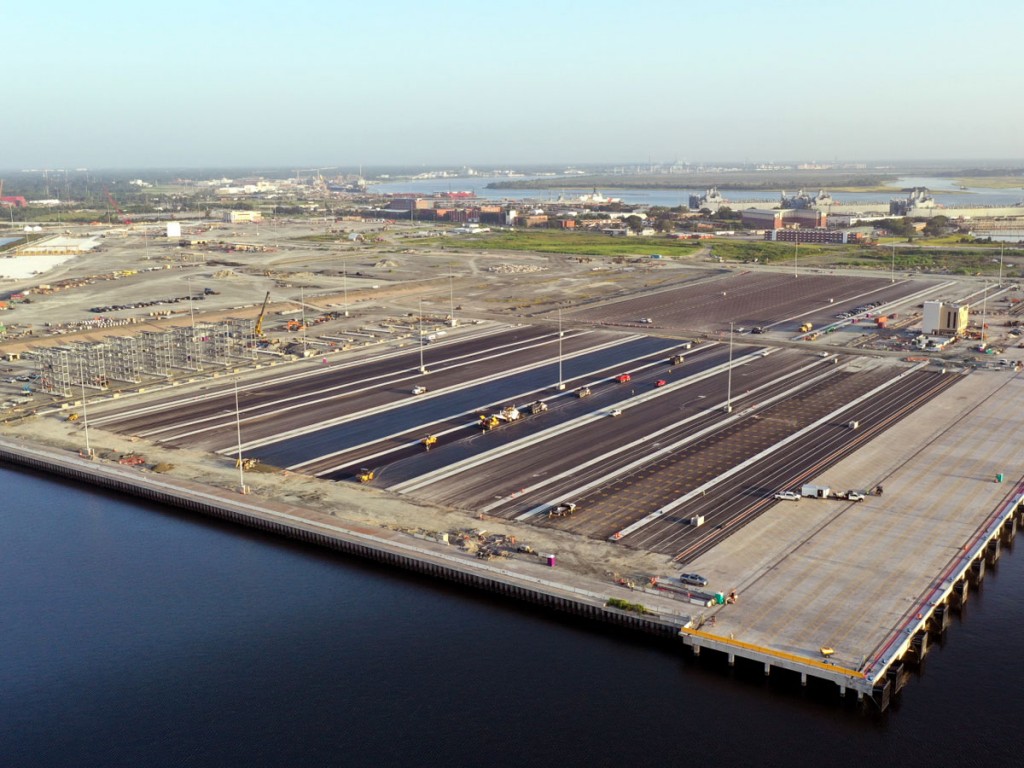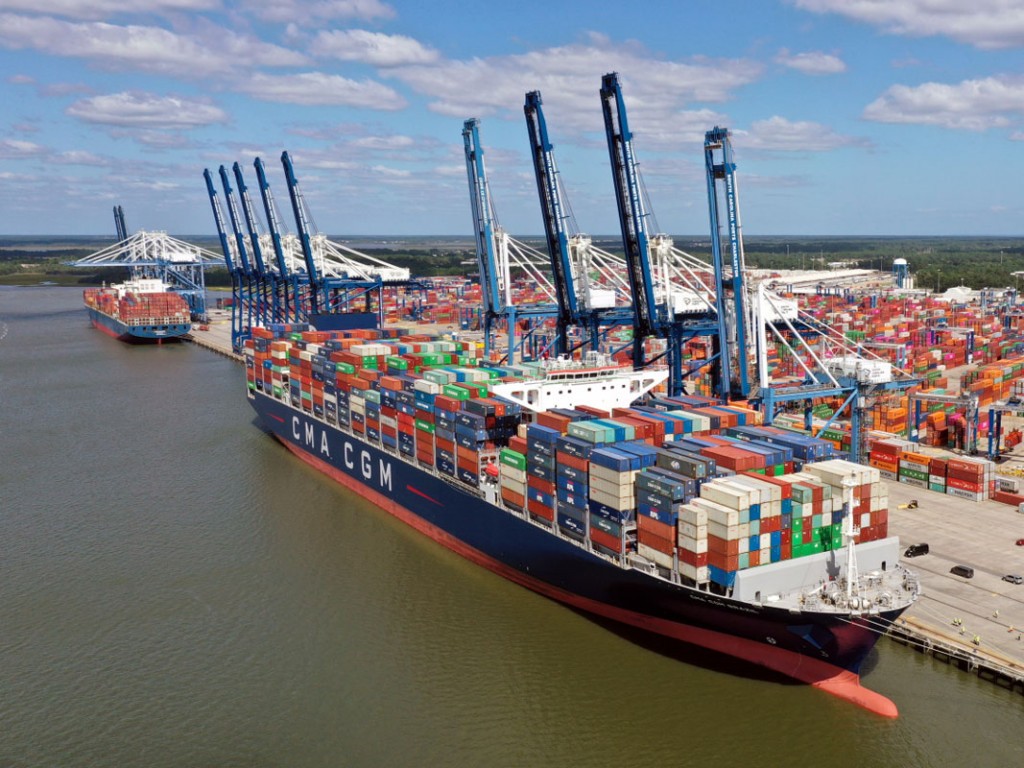Already an impressive U.S. Southeast commercial hub, the South Carolina Port Authority’s Port of Charleston is about to offer even greater capabilities for efficiently handling big boxships, with early 2021 boding to bring opening of the initial phase of the first new major U.S. container terminal in more than a decade.
Infrastructure investments totaling $2 billion over a six-year span also are delivering enhancements to existing container terminal abilities, while a 52-foot-deep harbor is just months away as well.

“If you look at the 10-year timeframe from the last recession up until 2019, we doubled our volume in 10 years, and that was largely due to the manufacturing business in South Carolina,” Newsome told AJOT, noting that a doubling of advanced manufacturing jobs in the Palmetto State has coincided with a doubling in Port of Charleston containerized cargo volumes. “It’s really amazing.”

Automotive and tire segments have led the way, he said. BMW has invested $10 billion in South Carolina since 1994, when the BMW Spartanburg plant opened in Greer, while Volvo unveiled a manufacturing facility in South Carolina’s Berkeley County in 2018. And SC Ports handles automotive cargos for beyond the state’s borders, including for the Mercedes-Benz factory in Vance, Alabama. Meanwhile, Michelin has multiple tire plants in South Carolina.
SC Ports appeared poised in its fiscal year ending June 30, 2020, to eclipse its record container volume of fiscal 2019 when the COVID-19 pandemic hit, resulting in a total 2.8 percent year-over-year decline in 20-foot-equivalent units moving through its container terminals for the 12-month period, with 2.32 million TEUs handled.
“Life looked pretty rosy, and then, all of a sudden, China shut down due to the pandemic, which meant a lot of the offshore manufacturing shut down,” Newsome said, adding that forecasting future volumes is now very difficult, with expectations hinging upon widespread vaccine availability.
“June was our low point, and July and August have been steadily increasing, as a lot of inventory had to be restocked, and, it’s a funny thing, but we say Americans buy stuff when they can’t go out to theaters and restaurants,” Newsome said.
“We certainly have not been just waiting for the market to take effect on our volumes,” he continued. “We have been very focused on business development, working hard on retail distribution and export transloading of plastics. We’re not content with simply saying the market takes us where it goes.
“We still believe, when all is said and done, that the Southeast remains the best place to be in the port business,” Newsome said, citing regional population growth, including with people moving from high-cost-of-living Northeast cities to more affordable Southern locales from which they can telecommute. “If you look at the real estate market here, one could argue, that trend is even accelerating because of the pandemic.”
With SC Ports building infrastructure based upon a 50-year outlook, the long-term impacts of COVID-19 do remain a bit of an unknown. But it remains clear that state-owned, state-operated facilities in the Southeast will continue to provide shippers with highly efficient, cost-effective solutions.
When Newsome joined SC Ports in 2009, the new North Charleston container terminal was already permitted. Now called the Hugh K. Leatherman Terminal, the facility is on schedule for opening its first phase in late March. He said a second phase could open in 2028, likely earlier if indicated by demand, with the third phase to be ready in the early 2030s. Development is taking place on a 286-acre site formerly occupied by a U.S. Navy base.
“It’s going to be a beautiful new terminal with tall cranes,” Newsome said. Five ship-to-shore cranes each with a lift height of 169 feet are to be in place along a 1,400-foot-long wharf, supported by 25 hybrid rubber-tired gantries, an expansive container yard and optimized operational technology.
The first phase at the Leatherman Terminal is to add 700,000 TEUs of annual throughput capacity at the Port of Charleston. Upon full build-out 2.4 million TEUs of yearly capacity are to be added, doubling existing port capacity.
At the same time as the new terminal is advancing to handle the megacontainerships of today and tomorrow, the Port of Charleston’s Wando Welch Terminal, which dates back nearly 40 years, is in the midst of $500 million of improvements for accommodating big boxships. By the end of 2021, the renewed Mount Pleasant terminal is to have 15 ship-to-shore cranes each with 155 feet of lift height, 65 rubber-tired gantries, more than 40 truck gates, modern temperature-controlled containerized cargo facilities and an on-dock transload facility.
A new high-efficiency Tideworks terminal operating system is to be implemented at both container facilities. And a new joint venture – Charleston Stevedoring Co. LLC – is optimizing use of the Port of Charleston’s terminal assets and resources.
Also moving forward over the past decade has been the effort to deliver a 52-foot-deep harbor, to enable access to
“We will have essentially the deepest harbor on the East Coast,” Newsome said. “We’re in really good shape there at a time when we think it’s needed. The ships are handling a lot of empty containers today, but, as the export market continues to grow, particularly with plastics and some of the commodities we’ve recruited here, the weights are getting heavier, so these ships will need deeper draft.”

These investments are to combine to enable the Port of Charleston to simultaneously handle as many as four 14,000-TEU-capacity containerships, with capability to accommodate vessels with a capacity of 19,000 TEUs. The port already is being called by some of the world’s largest containerships, including the 15,072-TEU-capacity CMA CGM Brazil, which arrived Sept. 20 at the Wando Welch Terminal. (See story )
“I think we’ve done a really exemplary job on our infrastructure,” Newsome said. “I’m very proud of what the team has done. It’s a lot of work together to make it happen, including a lot of support from the State of South Carolina.”
He pointed specifically to the $350 million put up in advance by the state for the harbor project, as well as $170 million in state funds for a new Port of Charleston access road.
“We do all of this on the strength of a strong maritime community here in Charleston,” Newsome said. “It’s not just the port. The port is 730 very important people, obviously, but the greater maritime community – truckers, ILA [International Longshoremen’s Association] and three crafts, distribution center workers – is probably 10,000 here.”
All told, South Carolina port operations facilitate 225,000 jobs statewide while generating nearly $63.4 billion in annual economic activity.
“We couldn’t do any of this without providing a great product,” Newsome said. “What has been the hallmark of this port is that we provide a really good product. That was the case when I joined the port, and, through the investments we’ve made and the growth, we’ve met all the challenges. That’s the case today, and it will continue to be the case here.”





